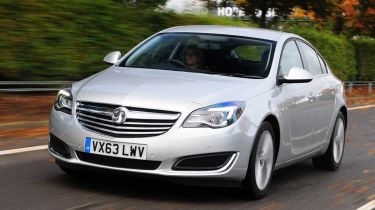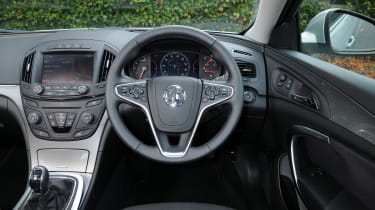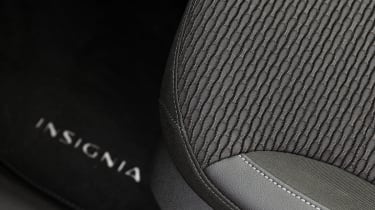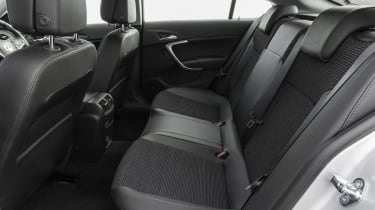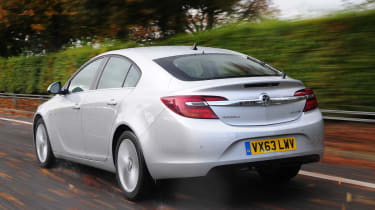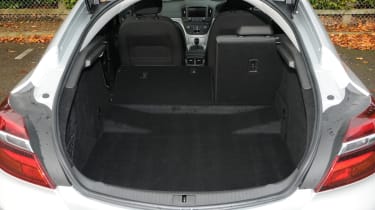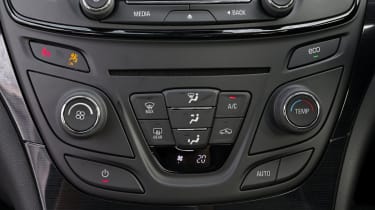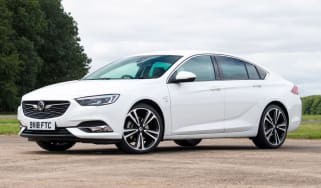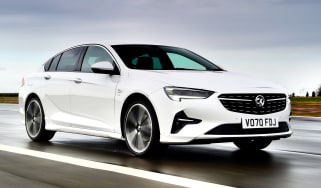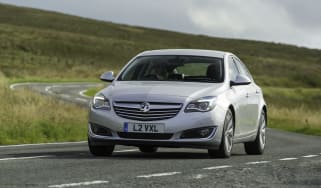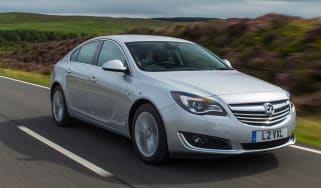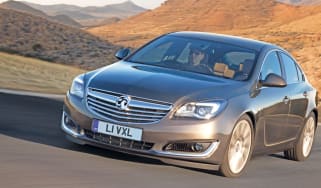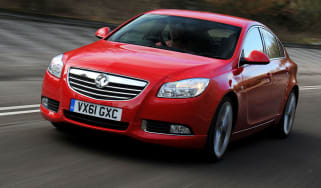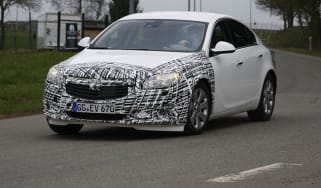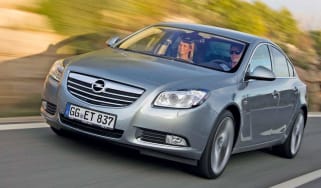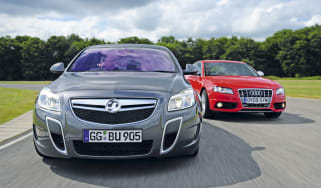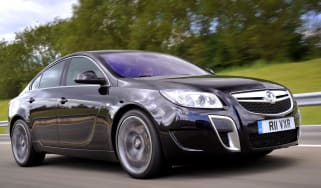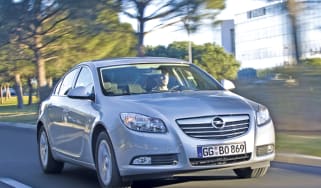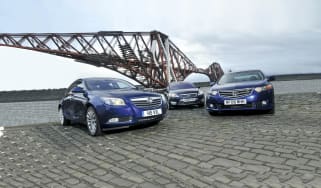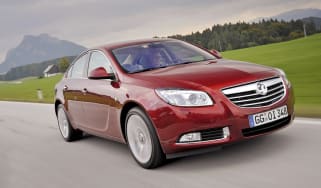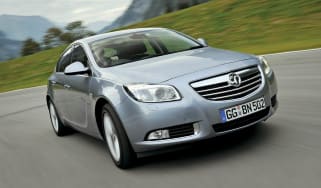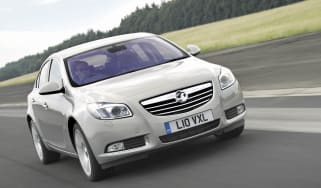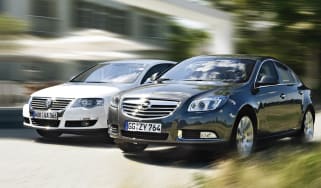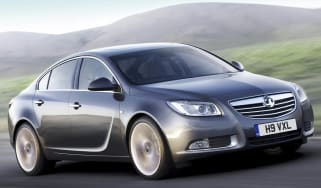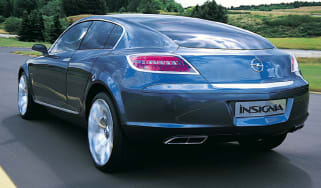Vauxhall Insignia (2013-2017) review
The Vauxhall Insignia hatchback offers plenty of style and comfort to rival the Ford Mondeo

The Vauxhall Insignia was the long-awaited replacement for the old Vectra - one of the least liked cars of all time. The Insignia came along in 2008 and improved on its predecessor in almost every way. But it still scored in Vauxhall's traditional territory - value for money. The Insignia, like its predecessors, is big, spacious and well equipped as standard, and since its launch has become a favourite in the company car park. It's not without its competitors, though, with mainstream rivals like the Ford Mondeo and Volkswagen Passat along with competition from further afield in the form of the Kia Optima, Skoda Superb and Hyundai i40.
The Insignia's job is made even harder with aspirational execs plumping for premium models that could only cost a few pounds a month more as a company car. Unfortunately for Vauxhall, the car is feeling its age after eight years on sale. A facelift breathed some new life into the range in 2013, though, replacing the mess of buttons on the centre console with a cleaner look and new touchscreen infotainment system, while the front of the car gained Vauxhall's updated 'family face'.
The 2013 update also brought tweaks to the chassis, including making the steering more direct and improving ride comfort. As a result, the Insignia feels a little fresher from behind the wheel, though it still can't compete with the best in the class for driving dynamics or comfort.
A broad range of engines is offered, with petrol and diesel options available - though most buyers plump for the efficient diesels. There's also a barnstorming Insignia VXR SuperSport, for those who like their saloons with plenty of power.
Used - available now

2023 Honda
Jazz
8,359 milesAutomaticPetrol1.5L
Cash £16,995
2023 Ford
Kuga
21,659 milesAutomaticPetrol2.5L
Cash £21,697
2023 Skoda
Kamiq
17,635 milesManualPetrol1.5L
Cash £15,197
2021 MINI
Cooper Electric
24,423 milesAutomaticElectric
Cash £12,697The Insignia also comes with a whole host of trim options, starting with the entry-level Design. The mid-range Insignia SRi is very popular, with the Tech Line model adding extra equipment and the VX-Line a touch of sportiness.
The plush range-topping Elite comes packed with loads of kit, such as 18-inch alloys, leather trim and dual-zone climate control. There’s even a high performance VXR model.
But the variety doesn’t stop there. As well as hatchback and saloon versions, Vauxhall offers a practical Sports Tourer estate – although the rugged Insignia Country Tourer, designed to rival the likes of the Volkswagen Passat Alltrack and SEAT Leon ST X-Perience, was dropped from sale in 2015.
The Vauxhall Insignia is a big family car that’s been around for a long while now. And while it’s beginning to show its age, a facelift and a new range of engines have kept it relatively fresh.
The latest ecoFLEX engines offer great efficiency and refinement, and the Insignia is a superb car for travelling long distances in. However, rivals like the Mazda 6, Volkswagen Passat and Skoda Superb have it beaten in terms of driver enjoyment.
It’s a practical choice, with plenty of space for driver and passengers, as well as their luggage, although its sleek roofline can make things tight for taller people in the back.
Standard equipment is generous and pricing is very competitive, especially as there are usually deals to be had. Just beware of plunging values over the course of ownership, which can have a big impact on overall costs.
Engines, performance and drive
The latest Vauxhall Insignia is incredibly comfortable and will happily eat up long journeys with ease. Tweaks made to the suspension in 2013 filter out the biggest bumps to deliver a comfortable ride, while wind noise is minimal and the engines are generally quiet – although petrol cars are definitely more refined than diesels. As a long-distance cruiser, this Vauxhall can’t be faulted.
But while the car offers buckets of grip and decent turn-in, it doesn’t come close to the Mazda 6 for driver thrills. There’s not much in the way of feedback through the steering wheel, and the pay-off for that comfortable ride is a rather soft feel through corners.
The Insignia suffers more body roll than the class leaders, and the suspension can easily be unsettled by mid-corner bumps. That said, SRi and ecoFLEX models get lowered and stiffened suspension, which does a better job of controlling body movements. The trade off for this increased cornering composure is a rather stiff ride, which causes the Insignia to crash into potholes and jolt over expansion joints.
The VXR model is the most dynamic to drive, thanks to its electronically controlled four-wheel drive transmission and special HiPerStrut front suspension system. This system helps eliminate torque steer and improve steering response. As a result the VXR feels remarkably agile for such a large car, while the all-wheel drive delivers strong traction out of the corners. Better still, this high performance flagship gets adaptive damping as standard. In its comfort mode this system delivers a remarkably supple ride, while selecting 'VXR' tenses the suspension and serves up strong body control.
Engines
The Insignia offers a pretty varied array of engines, so there should be something to suit all needs and budgets. The range kicks off with an entry-level 1.8-litre petrol unit. It offers enough power at 138bhp, but it's naturally aspirated and feels a little breathless in such a big car. Economy isn't great, either.
Surprisingly, the small-capacity 1.4-litre turbocharged petrol engine has the same 138bhp power output, but it offers more torque, flexibility and performance. It’s smooth and quiet, although it still lacks oomph. If you want that, Vauxhall’s 246bhp 2.0T SIDI petrol engine is much more potent.
However, easily the strongest performer in the Insignia range is the VXR SuperSport model, with its mighty 320bhp 2.8-litre V6. This 168mph super saloon is one of the fastest cars on sale in the UK in its price bracket, taking just 5.6 seconds to sprint from 0-62mph.
As of summer 2015, there was big news for the Insignia on the diesel engine front. Vauxhall’s new 1.6-litre ‘Whisper Diesel’ engine replaced lower-powered versions of the 2.0 CDTi diesel. This new 134bhp 1.6-litre is impressively responsive and smooth, while remaining remarkably refined. In ecoFLEX form, the engine delivers a top speed of 130mph and 0-62mph in 10.9 seconds. It's easily the pick of the bunch as it offers ample performance with CO2 emissions that dip below 100g/km. However, it doesn't quite live up to its 'Whisper' billing, as it clatters a little when cold and gets gruff when extended. That said, you don't need to wring the Vauxhall's neck because it delivers a healthy 320Nm of torque at just 2,000rpm, and at a cruise the engine is remarkably refined.
A 167bhp 2.0 CDTi diesel remains available, offering excellent acceleration and flexibility. The fastest diesel of all – the 192bhp 2.0 CDTi Bi-Turbo – was dropped from the range in 2015. Unfortunately there’s no hybrid Insignia, whereas other brands are increasingly offering this option.
MPG, CO2 and Running Costs
Company fleets account for most Vauxhall Insignia sales, so by far the majority of cars on the market are diesels. The efficient ecoFLEX diesel engines make the most sense. Crucially for fleet managers and company car drivers, the 1.6 diesel model achieves 99g/km CO2 emissions when specified with 17-inch alloy wheels and low-rolling-resistance tyres, and claims 74.3mpg fuel economy. That’s very impressive for such a large car, even if it’s now been beaten by the new Ford Mondeo (which goes as low as 94g/km and 78.5mpg). However, the Vauxhall counters this with lower list prices, which helps make the Insignia a more attractive company car choice.
The most powerful current Insignia with ecoFLEX technology is the 2.0 CDTi model, which has CO2 emissions as low as 114g/km and fuel economy of 65.7mpg.
Among the petrol options in the Vauxhall Insignia range, the 1.8i isn’t a very economical choice (it claims 40.4mpg and 169g/km). The 1.4-litre turbo is much more attractive, with CO2 emissions of 123g/km and 54.3mpg economy – but again Ford beats this with its Mondeo 1.0 EcoBoost, which emits less than 120g/km of CO2, albeit with slightly less power on offer.
As you’d expect, the 2.8-litre twin-turbo VXR SuperSport is a real gas guzzler, while the nippy 2.0-litre SIDI petrol Insignia is hardly the most efficient option, either, with 39.2mpg economy and emissions of 169g/km.
Insurance groups
The Insignia has keen insurance group classifications by class standards, which should help to keep costs low. The popular 1.6 CDTi ecoFLEX sits in either group 17E or 18E, while the 1.4T model starts in group 15E and the 1.8i in group 14E. Don’t expect the 2.8 VXR to be cheap to insure, though: it sits in group 36E.
Depreciation
A lack of badge kudos and the fact that big savings are available new means that the Insignia doesn’t hold on to its value well – in fact, it’s one of the weakest performers on the market in terms of residuals. So when buying new, you need to ensure you negotiate a large discount. Thankfully, as Vauxhall includes plenty of kit as standard on the car, you shouldn’t need to spend too much money on options.
Overall, the Insignia isn’t a great investment over the short to medium term – the Volkswagen Passat and Skoda Superb fare much better here. Yet the upshot is that the Vauxhall makes an excellent buy nearly new, with ex-demonstraters and pre-registered models available with thousands of pounds slashed from the new price.
Interior, design and technology
Like its Ford Mondeo, Volkswagen Passat and Skoda Superb rivals, the big Vauxhall is a firm favourite with fleet buyers, and Insignias are a common sight trawling the UK’s motorway network.
Compared to the Mondeo, which can appear bulky, the Insignia is one of the better-looking large cars out there, thanks to an arching roofline that tapers to a shallow rear screen and a raised tail.
What’s more, Vauxhall’s 2013 facelift improved on the original Insignia’s sharp design by adding a larger grille and revised LED headlights. Higher-spec cars also get a reprofiled chin spoiler with foglamps, and the hatchback model’s tail-lamps are joined by a thicker chrome bar across the tailgate. In fact, from some angles the Vauxhall Insignia is reminiscent of the Volkswagen CC.
The interior changes introduced in 2013 are equally subtle. The steering wheel is the same as the one fitted across the rest of the Vauxhall range and the curvy dashboard found on the first-generation Insignia is largely unchanged.
Sat-nav, stereo and infotainment
Vauxhall has reduced the number of buttons on the centre console, as all Insignias now get a touchscreen to navigate through the major functions.
Opt for a model equipped with sat-nav, and you also get a touchpad that’s used to work through the menus and write characters. This IntelliLink system features Apple CarPlay connectivity, so you can hook up your smartphone to access in-car entertainment apps for things like music and news. You can also use audio streaming, have text messages read aloud and play videos. The navigation system can be displayed two or three-dimensionally, and can be controlled by voice command.
All versions of the Insignia feature a digital radio as standard, with steering wheel-mounted controls. A Bose Premium sound system is optional, providing excellent clarity.
One of the most appealing extras Vauxhall offers for the Insignia is the eight-inch TFT instrument cluster. This costs around £400, and replaces the traditional analogue dials with a large screen that can show a range of information, from speed and revs to economy and driving efficiency. The system looks and feels very modern thanks to its clear, colourful display.
New to the Insignia from summer 2015 is OnStar, which provides in-car Wi-Fi, notifies the emergency services if the airbags are deployed and also includes a direct connection to call centre advisors. It’s standard on Elite, Limited Edition and VXR trim levels, and a £395 option on other models.
Practicality, comfort and boot space
In this competitive market, the Vauxhall Insignia has traditionally been one of the most practical cars, offering generous room for people and luggage. That’s still the case, and although more modern rivals now offer more space, the car remains a comfortable choice for five passengers.
Size
At 4,842mm long and 1,856mm wide, the Insignia has always been among the largest cars in its class, but the latest crop of rivals has now started to outgrow it. For example, the latest Ford Mondeo is slightly longer than the Vauxhall (at 4,871mm), as is the Skoda Superb (4,861mm), although the Volkswagen Passat is rather smaller (4,767mm long and 1,832mm wide).
Leg room, head room & passenger space
Given its large dimensions, it’s no surprise that the Vauxhall Insignia comfortably accommodates five adults. However, its sweeping roofline means that taller rear seat passengers may find their heads brushing the rooflining. That's not a problem on the estate model, though. And on our preferred model – the Insignia SRi Nav 1.6CDTi 136PS – electric seat adjustment for the front passenger is an optional extra.
Boot
On hatchback models, there’s 530 litres of boot space with all seats in place. When the 60:40 split-folding rear seats are lowered, this expands to 1,470 litres. Yet while these figures are generous, they can’t quite match the biggest rivals in the class; for example, the huge Skoda Superb has luggage capacities of 625 and 1,760 litres respectively.
The boot of the Insignia has a narrow opening, although the floor area is a usefully squarer shape than in some of its rivals. In the Vauxhall there’s also an awkward step in the load floor, but this is no different to the Mondeo; the difference is that you don’t have to flip the seatbases up to achieve a full-length platform in the Ford.
Vauxhall has been generous with the storage space inside the Insignia, giving it plenty of cubbies, a lidded compartment between the front seats and a large glovebox.
Reliability and Safety
According to feedback from the Auto Express Driver Power 2015 satisfaction survey, the Vauxhall Insignia isn’t the most dependable car on the market. It ranked in a lowly 170th place in the reliability category of the poll.
The interior makes a decent impression, using good-quality materials. The upmarket feel is enhanced on higher-spec cars, which come with leather upholstery and plusher trim than on entry-level and mid-range versions. However, owners who have lived with the car for some time score it down for build quality (the Insignia ranked 159th in this category in Driver Power 2015).
As for safety, Vauxhall hasn’t scrimped on kit. The Insignia comes fitted with six airbags, ESP and two Isofix child seat mounts in the rear as standard. What's more, Euro NCAP awarded the car a score of 94 per cent for adult occupant protection in its independent crash tests, and gave it an overall rating of five stars.
However, it’s worth pointing out that the Insignia hasn’t been tested by Euro NCAP since 2009, so this doesn’t mean quite the same as the five-star rating achieved by the BMW 3 Series in 2012.
A raft of advanced safety kit is available on the Vauxhall options list. This includes a rear-view camera, plus a park-and-go technology pack with blind spot and rear traffic alerts.
Automatic lights and wipers can be added to lower-spec Insignias as extras, as can Vauxhall’s auto-park system and front and rear cameras. The front camera pack option includes lane departure warning, adaptive cruise control and forward collision alert. Optional OnStar also alerts the emergency services automatically if the airbag deploys.
While all this kit hikes the price, it keeps the Insignia among the best cars in its class for safety equipment. Even so, modern rivals like the latest Ford Mondeo have definitely caught up in this regard, and offer things like city braking, which Vauxhall does not.
Warranty
Vauxhall used to supply a unique lifetime warranty, but that was scrapped for new cars as of January 2015. Instead, the company currently offers a three-year, 60,000-mile warranty that’s much more in line with industry averages. It’s still possible to extend the warranty, at extra cost, up to 100,000 miles. Brands offering more generous warranties include Toyota (five years), Hyundai (five years) and Kia (seven years).
Servicing
The Insignia range benefits from 20,000-mile service intervals, which are longer than most cars, but to maintain the warranty you’ll still need to have a service carried out at least once a year. Optional service plans can spread the cost of dealer maintenance, and offer discounts on wear and tear items.
